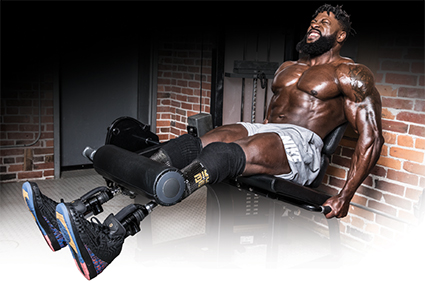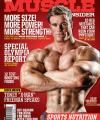TRUE GRIT: Bionic Body Interview

This feature’s title isn’t just the name of an old John Wayne western—it’s also an expression that defines someone’s character as having the strength of courage to see through one’s convictions even in the face of seemingly insurmountable adversity. Having “true grit” suggests a person with a forceful, strong, and truly unrelenting spirit. You can call that courage, honour, fortitude, or braveness. But here at Muscle Insider, we call that the unstoppable Edgard John-Augustin—better known to the bodybuilding world as the Bionic Body.
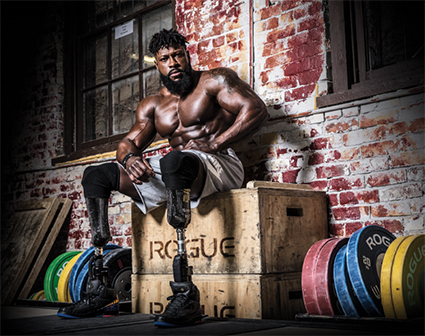
Probably the most overused storyline in sports reporting is the one in which the subject overcomes some sort of hurdle yet manages to persevere and finally achieve his dream. Maybe it was a torn fingernail, a bad case of dandruff, or the death of his pet hamster. Surely this tired cliché should’ve been retired long ago.
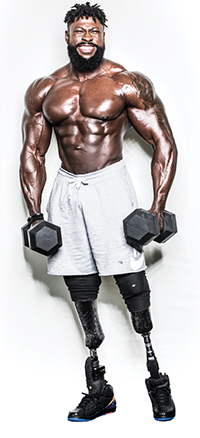 But once in a very long while, a story is so utterly compelling that it’s almost impossible to fully capture in words given its larger-than-life significance.
But once in a very long while, a story is so utterly compelling that it’s almost impossible to fully capture in words given its larger-than-life significance.
You might see 34-year-old Frenchman Edgard John-Augustin hanging around the Arnold Classic and think nothing of the 6'2" densely muscled big man: just another massive guy among the beasts hanging out in Columbus, Ohio, for the annual event. But you’d have to look more closely to realize he’s anything but like everyone else. A horrific auto accident when he was a child left Edgard without his lower legs, and his brother permanently missing one. Edgard’s story is one of triumph, of how he moved from Guiana to France to learn how to adapt to his injuries, and later, of dealing with bullying and obesity and how he eventually discovered bodybuilding and used it as a way to transform his life.

Surely you can see on these pages how Edgard’s story ends, but Muscle Insider found it so inspiring we wanted to share it with our readers. It’s said that a picture is worth a thousand words, but we could fill every page of this issue with photos and still not have given due justice to the force that drives him. We sit down with this unstoppable man and get the real story of the Bionic Body and how he inspires millions around the world.
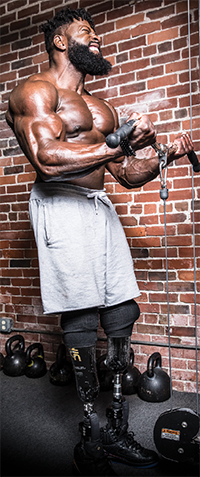 MUSCLE INSIDER: Edgard, tell us briefly about the car accident and how it changed your life?
MUSCLE INSIDER: Edgard, tell us briefly about the car accident and how it changed your life?
EDGARD JOHN-AUGUSTIN: I was just four years old when I lost my legs in a car accident, and my brother lost one as well. My mom was driving, and it’s been really hard on her ever since. From that day on, I knew that God was with me.
MI: As tragic as the accident was, it made your life more challenging in a number of other less obvious ways as a youth. What stood out?
EDGARD: When I was a kid, I was doing my best to do everything as the others like running, climbing trees and even swimming. I often missed school because of my surgeries and I was more comfortable spending time with my brother. As a teenager, I also had to deal with overweight and even obesity challenges, so it wasn’t easy by any stretch. But my family has always been there for me, so my memories of childhood are positive.
MI: What prompted you to start lifting weights? Were there any individuals who inspired you early on?
EDGARD: I started going to the gym at the age of 20 because I had to deal with stress not just because of my exams but also because I came to greater Metropolitan France for my studies. From that first day, I never stopped. It simply made large, wholesale changes in my life.
Of course, Arnold is one of my inspirations, but I’d also include Dwayne “The Rock” Johnson and Will Smith. I appreciate the way they take on and succeed in so many large projects.
MI: Obviously, exercises like deadlifts, squats, and lunges require that you get sensation through your feet, which helps you maintain balance as your centre of gravity changes as you go through a given movement. Have you managed to compensate for that lack of sensation?
EDGARD: Yes, but it was very difficult and even frustrating for me. I had to learn how to adapt exercises, but as with everything in my life, it doesn’t stop me: I adjust by finding another way to do a movement. Posing is also very hard because I have no balance.
MI: So let’s talk leg training in particular, as we clearly see some exceptional thigh development, as well as glutes. How do you build them without traditional multi-joint exercises?
EDGARD: Despite my misfortune early in life, I still have my knees [where the quads and hamstrings attach to], so I can still go through a full range of motion and achieve maximal contractions. I can do exercises like legs extensions, leg presses, and squat-machine leg exercises. Regarding the fact that I have no balance, I can’t do free squats, so I do squat machine and hack squat instead. Even still, with lower body exercises, I still have to make adaptations to feel the pump, but overall, I simply can’t get the same results and even with the accommodations I make, my results are still affected.

MI: Is your body somehow affected in other ways that most of us take for granted because of the training volume and intensity?
EDGARD: I feel a lot of daily pain, and I have a lot of injuries because of the prosthetics, as well as added stress just from gaining or losing weight. This is the most difficult aspect for me to deal with. Some days I can barely walk, and this is hard when you’re confronted by your own limitations. I still continue even if I bleed, but mentally and physically it’s still hard when it happens.
MI: How did you decide you wanted to compete, and what was the result?
EDGARD: When I started training, it was just for fun and to lose weight. My results were pretty good, and people at the gym started to tell me about competitions. It made its way into my head, and I decided to start preparing for my first show in 2015. I started competing as a disabled athlete. I won my category in 2015 at GP des Pyrénées. After this show I did the European Championships wheelchair category and won. In 2016, I won both shows I entered for disabled athletes. I got my pro card in 2017.

MI: How were you received as a professional bodybuilder?
EDGARD: I do my best and work hard to be seen as a great bodybuilder, not just as a handicapped athlete. I think others can see my hard work and dedication. Before having a pro card, I was competing with other disabled athletes and most of the time not in a wheelchair because it wasn’t necessary. But with a pro card, I don’t have a “category,” so I can’t compete with wheelchairs, and really it’s difficult for the judges to judge me against the other athletes. Even still, my biggest pride is standing onstage next to awesome bodybuilders I’ve so long admired.
It’s hard because even though I’m 200 percent dedicated to achieving my best, I know my chances of winning are essentially nonexistent, but that doesn’t stop me. I’ve already won everything just being onstage, and I’m ready to do it again this year with even better shape.
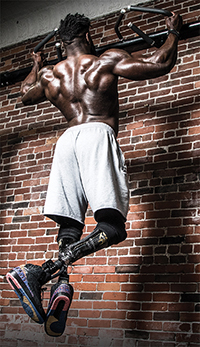 MI: We’ve seen you at a few of the U.S. bodybuilding expos like the Arnold Classic and Olympia. Do you get stopped by fans, and what are the kinds of things they’re saying?
MI: We’ve seen you at a few of the U.S. bodybuilding expos like the Arnold Classic and Olympia. Do you get stopped by fans, and what are the kinds of things they’re saying?
EDGARD: Yes, it’s always incredible for me to see everyone who’s waiting for a pic or to chat with me! Expos are incredible: I literally can’t sit down because I am asked so many questions. And it fills me with joy and gratitude! People often tell me that I’m a real motivation for them, and they say, “If you can do it, everybody can!”
MI: Would you say the activity and sport of bodybuilding have helped make you a stronger person?
EDGARD: Oh yes, for sure! It gave me rigor and a framework in life. To make progress, you have to be committed, and I carry that over to other areas in my daily life. With bodybuilding, you can’t have days off. I work out hard, I lose weight, the stumps rub on the prosthetics and it hurts and bleeds, but I keep going because that’ll never stop me from my goal. My mental approach is stronger than my handicap, and bodybuilding has taught me the importance of dedication no matter what.
MI: Whether by choice or not, you’ve become an important role model for others. Is there a message you like to tell people?
EDGARD: As I always say, “Do it! Nobody will do it for you!” It’s true for everything in life, sports, jobs, family, dreams….
MI: Tell us what you currently do and about your life in France.
EDGARD: I’m married and we have two boys; my eldest son, Mayron, is nine and my younger will be two this July. I try to share a little of our family on Instagram because bodybuilding isn’t my whole life, even if it is a big part, because among other things, there’s the diet! I travel a lot around the world and France for exhibitions and openings at shops and gyms, and I’m really grateful for the opportunity! When I’m travelling, I keep my diet and training on point, and when I’m at home, I do my fasted cardio before breakfast and then train in the morning so I can spend quality time with my family in the afternoon and evening. My family is my pillar.